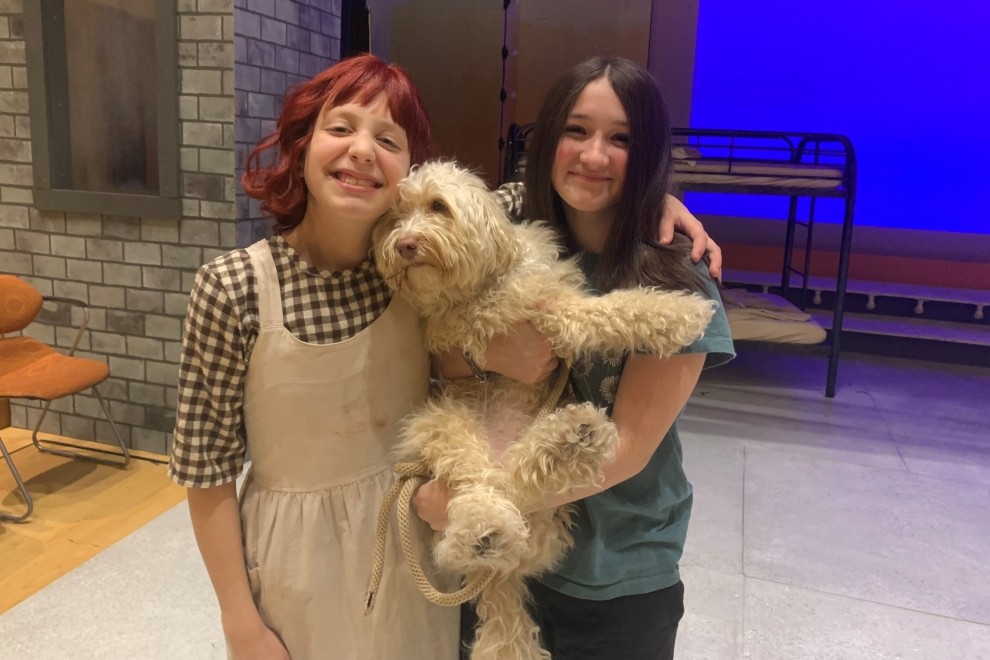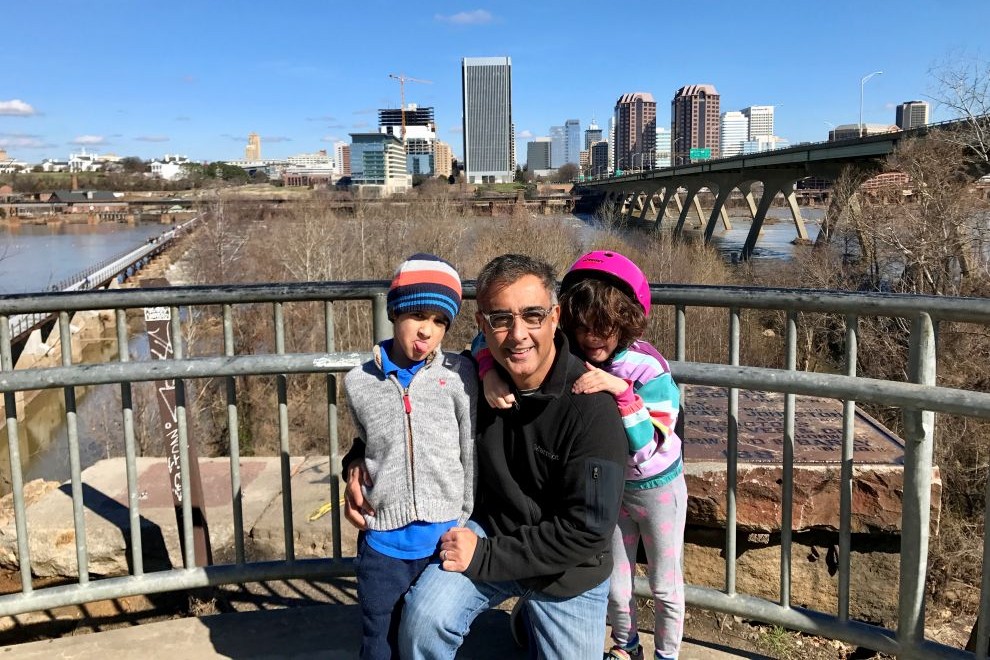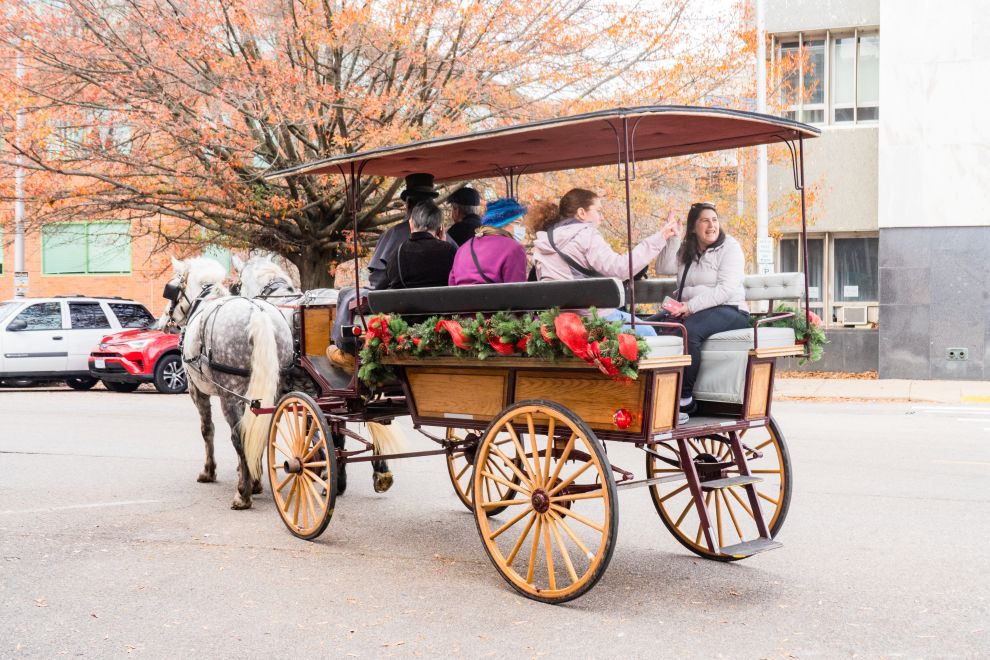Richmond and Philadelphia are cities both rich in history and thriving today. They are capitals – Richmond is our commonwealth’s capital city, and Philadelphia served briefly as our nation’s – and both are built on rivers. Both have a plethora of tattoo shops. But there’s another link. There’s a man who grew up in Philly, inspired by its art scene, and has since moved to Richmond and is inspiring families across the region.
Hamilton Glass began creating murals in Richmond in 2009, just two years after moving to the city. Now you can find the Philadelphia native’s art all around town, from a juvenile detention center gym to a soccer complex building.
Hamilton, thirty-four, creates his eye-catching murals with an affinity for bold colors, a penchant for geometric shapes and forms, and a flair for innovation. His works of art reflect not only his love of art, but also his training in architecture. “It’s my husband’s passion and dream to be an artist,” says his wife, Taekia, a former architect who is now program director of Art 180. “He’s able to live that dream out and share it with others.”
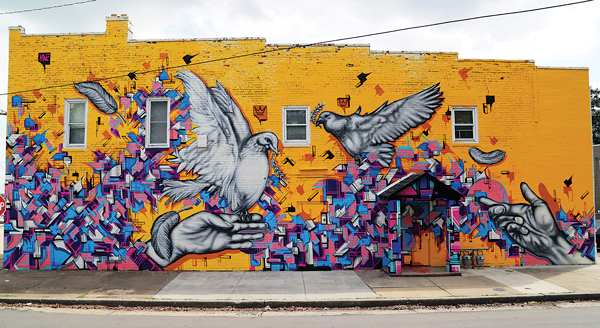
His murals, she believes, create a sense of community and pride in the city. “He’s found a great way of working with organizations to share his love for art,” she says.
The two met when they were both working as architects in New Jersey. After they moved to Varina, Hamilton encouraged her to get involved with Art 180 as a volunteer. She encouraged him to follow his dream.
Taekia describes her husband’s work as “bold and expressive. You always know when it’s a Hamilton Glass piece,” she says. And as for the man himself, she sees him as “down-to-earth, honest, patient, and caring. One of the things I think people really admire about him is his work ethic. He’s usually up before I am, and he stays up until he accomplishes what he thinks needs to be accomplished.”
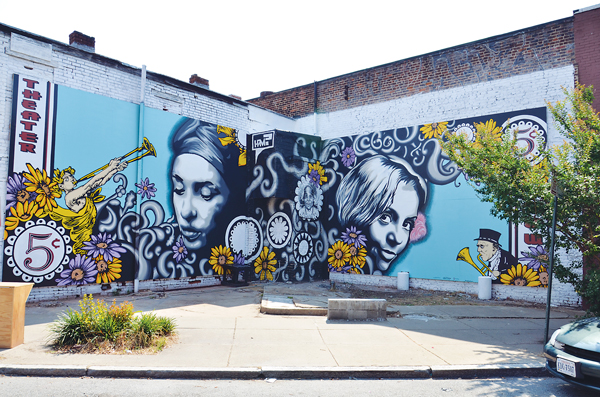
The couple’s 5-year-old daughter, Sanaa, is a budding artist herself. “She loves crayons and drawing,” Hamilton says, adding that she likes to come into his studio at home and paint with him. “She tries to imitate me a lot.”
One of Sanaa’s favorite activities is creating art with sidewalk chalk on the driveway, but she also paints with her mom and dad. “Hamilton and Sanaa made me a really pretty painting for Mother’s Day,” Taekia says.
Like his daughter, Hamilton always had a pen or pencil in his hand as a youngster in Philadelphia. His mother fostered his creativity by enrolling him in art classes in schools such as the Philadelphia Art Institute. “It was sort of therapy for me,” he says of his art. “I have always been creative, but I had the notion you couldn’t make a living in art.”
He ended up majoring in architecture at Hampton University. After graduation, he worked as an architect in Philadelphia, New York, and New Jersey. But he found that he didn’t enjoy the technical, day-to-day aspects of his job. “It took all the creativity out of me. I believe architecture is about art, about making and presenting beautiful projects,” he says. “I am more about the art and less about the technical aspects.”
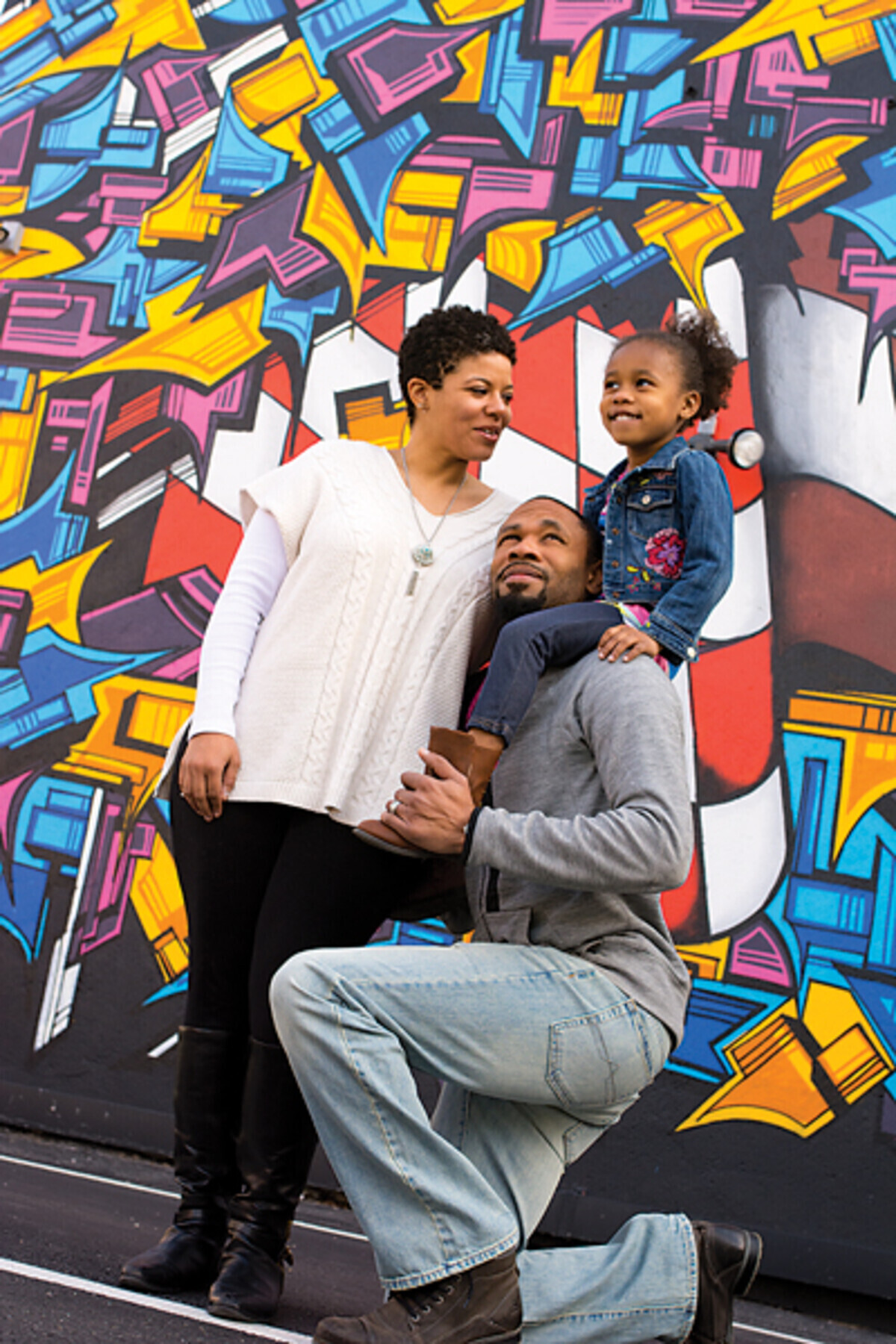
He didn’t consider art as a career until 2009 when the recession took a toll on the architectural industry and he was laid off. “I started doing my art a little more, and I got brave and started showing my work,” he says.
Doors began opening for him after he got the opportunity to create a mural in Richmond. Mural art was prevalent in Philadelphia when Hamilton was growing up. Philly’s Mural Arts program began in 1984 as part of the efforts of the Philadelphia Anti-Graffiti Network to eradicate graffiti from the city.
“I looked to them as inspiration growing up,” Hamilton says of the murals. “That was one of the reasons it wasn’t a big deal for me to do my first mural.”
His first mural, titled Recession 2009, sparked controversy in Richmond. The mural, painted on the wall of ALB Tech in the VCU area, depicted a politician holding a gun to his head.

“There weren’t a lot of murals in the city, so that was a little much for Richmond,” he says in retrospect. “My client said do whatever you
want, and I did. I didn’t think a politician holding a gun would get a lot of attention, but when I look back, I wonder what I was thinking.” Hamilton ended up replacing the mural with another that showed a politician with an American flag over his mouth to represent censorship.
The mural brought attention to his art. “That whole project made me know I wanted to be a muralist. It showed me how awesome it was to have people consume your art publicly,” he says. “I saw this as a viable dream, making art for a living. Since then, I have been working hard and partnering with different organizations, looking for niches I could get into to further my art career.”
Today about 70 percent of the artist’s work is murals. He also does graphic design and paintings. Although most of Hamilton’s artwork is in Richmond, he has also worked in Maryland, San Francisco, Texas and Washington, D.C. He’s made it a point not to overextend himself. “I don’t have a lot of clients on purpose because it’s demanding,” he says of creating murals. “Murals are very taxing on the body. They are not the easiest things to do. By March, I am usually burned out so I take a few weeks off and then go back to it.”
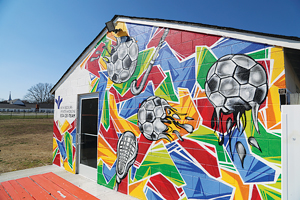
His work is varied. He has created corporate murals that depict a company brand and community murals that tell a story. He’s done playful renderings and social commentary. “There is a time and place for everything,” he says, noting that he also enjoys regular art as much as he does murals. “One of my goals is to do more canvas work than I do now.”
Many of his murals in and around Richmond are community-based projects. HandsOn Greater Richmond, an organization that connects volunteers to opportunities in the community, has partnered with Hamilton to complete numerous murals in the Richmond area, involving hundreds of volunteers.
“We have done murals inside several Richmond public schools, like George Wythe High School and Albert Hill Middle School, and on the interior or exterior of various nonprofits’ buildings… including Diversity Thrift, Neighborhood Resource Center, Boys and Girls Club, and Boaz & Ruth to name a few,” says Kristen Wiley, corporate program manager with HandsOn. “We also completed a large quantity of mural panels that were installed in various locations around Richmond leading up to 2015 UCI Road World Cycling Championships.”
Hamilton has a special way of involving volunteers in a “paint-by-numbers style that enables them to be confident and connected contributors during a mural’s execution, regardless of their artistic expertise,” she adds. “He has a way of using his artistic style as a vehicle to carry out the requests and ideas put forth by the benefiting school, organization, or business to create murals that are memorable works of art.”
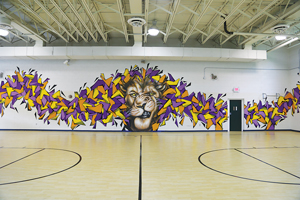
One of Hamilton’s most unique projects in the city was The Light of Human Kindness Wall at the GRTC Bus Depot that he created with Richmond-based social impact artist and photographer Patience Salgado, known as Kindness Girl. Completed during the 2013 RVA Street Art Festival, Salgado collected stories of people who had gone through dark times but found hope or light during those times. The stories were the basis for Hamilton’s mural, which contained a thousand LED lights. “I was able to use conductive paints that had hot spots,” he says. “It was the most fun project I have ever done.”
Hamilton will take part in the 2016 RVA Street Art Festival, scheduled for later this month at the Southern States Silos on Fourteenth Street, south of the Mayo Bridge.
Beth Jones, a Henrico County art teacher at both Godwin and Douglas Freeman High Schools, likes the fact that Hamilton does a lot of community projects. “I love the work he did with the lights,” she says of the GRTC project. “I particularly like his work because it has an edgy, graphic nature to it.”
During a class sketchbook assignment, several of Jones’ students chose Hamilton as the RVA street artist about whom they wanted to learn more. And many of the teens got to meet him, as well as artist Matt Lively when the two collaborated on public art at Regency Square Mall. “Matt and Hamilton came to Freeman and talked to the students,” Jones says. “We got to see their work at Regency Square Mall and got to know them.”
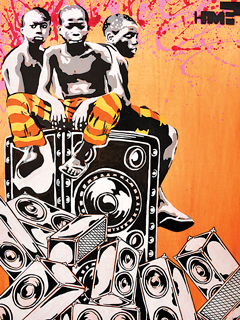
Hamilton and Lively, who graduated from VCU with a degree in sculpture, have worked on seven or eight projects together. “I love Hamilton as an artist,” Lively says. “The reason I wanted to work with him is that his thought process is vastly different than mine. I was curious about his process and how he makes decisions and how I respond to those decisions.”
He finds that Hamilton’s color philosophy is always consistent and sophisticated. “Every time I see his work, I am envious as to how he uses colors,” Lively says. “He is bold with his decision making. I love the energetic nature of the finished work and the way he works. When I work with him, I stand back and watch to see what he is going to do next.”
Lively also appreciates Hamilton’s work ethic. “I can’t compare it to anybody. It’s enviable,” he says. “Hamilton has a lot of energy.”
Architecture still continues to have a profound influence on Hamilton as a designer. “I like that it transfers in both my murals and my canvas work,” he says.
His work with murals is part of the thriving mural scene in Richmond. “The blooming of arts and culture in Richmond is across the board,” says Scott Garka, president of CultureWorks, an organization that works with the community through arts and culture. “Murals are one of the most visible things people talk about in the arts and culture scene. They create a lot of conversation.”
He sees the evolving mural scene in Richmond as a draw for tourists. “I am seeing that more and more,” he says. “This has a revitalization component to it. I’ve noticed it exploding in the last five years.”
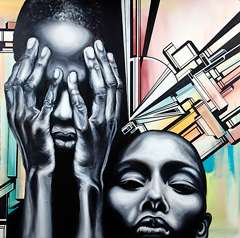
Wiley of HandsOn also sees a rise in the demand for murals. “We regularly have organizations reach out to us directly or to our artist partners, seeking murals for their spaces,” she says. “We have also found that community members love participating in these mural projects. Opportunities
like these foster a connection between the individual and the community. They enable volunteers to contribute to the beautification, enrichment, and overall atmosphere that makes Richmond such a uniquely wonderful place to live, work, and play.”
The Richmond region’s street art scene has garnered national recognition over the past couple of years with nods from The Huffington Post and Bon Appetit. “Visitors love seeing the artwork that adorns buildings here,” says Erin Bagnell, public relations manager for Richmond Region Tourism. “The beautiful street art helps visitors grasp what we all know – that arts and culture are a huge part of what makes this a great destination. It’s become a big part of the region’s identity and something that we’re incorporating into our overall marketing strategy.”
Taekia believes the true purpose of mural art is to embolden a community and inspire people. “I would like to see them all over the Richmond area,” she says.
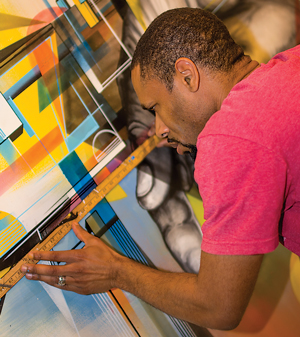
The scope of murals in the area continues to grow. This year marks the fifth year for the Richmond Mural Project, which brings muralists to Richmond. “Our mission is to bring tourism into the city of Richmond, which is a cool art town,” says the organizer, producer, and curator of the Richmond Mural Project, Shane Pomajambo.
So far the project has produced eighty-six murals but the goal is to reach one hundred murals. “That is pretty substantial,” says Pomajambo. “This is different from any other mural project in the world. We are doing it citywide. Typically you see murals in under-developed areas such as a warehouse district or on abandoned buildings. What’s wonderful about this project is you get to discover a city. We are putting up murals as often as possible in the most public areas.”
Last year during the mural project, Garka talked with James Bullough, one of the international mural artists participating in the event. Garka asked him what he thought of Richmond. “He told me that he and several of the international artists had been talking about how impressive they find the Richmond arts scene,” Garka says. “They’re encouraging their peers to check out Richmond, too.”
Murals and outdoor art are a visual representation “that is an important part of Richmond,” says Lively. “We have an enormous art community here.”
Even though Richmond has fewer murals than a city like Philadelphia, the murals still make an impact. “I think per capita there is an advantage to the fact we are a smaller city,” says Hamilton. “One mural here counts for about ten in Philly. They are louder and get more attention than one single mural in Philly.”
He knows of twenty artists in Richmond creating outdoor art murals. “There are more and more people that want to do it,” he says.



